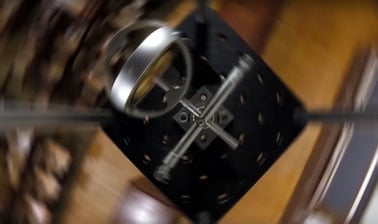The online buoyancy simulations on this page will help you understand the physical fundamentals that make some objects float and others not and, in particular, you will see how Archimedes’ Principle works.
Buoyancy is the ability of bodies to stay on the surface of a liquid or in the air without sinking. It is a fundamental physical principle governed by Archimedes’ Principle, enunciated by the Greek scientist of the same name.
Archimedes’ principle is a physical law established by the Greek scientist Archimedes, which describes the behavior of bodies immersed in fluids, either liquids or gases. This principle states that a body fully or partially immersed in a fluid will experience a vertical and upward thrust equal to the weight of the fluid displaced by the body. When a body is immersed in a fluid, either completely or partially, the fluid exerts a pressure on the body in all directions. The thrust is the resultant force of all these pressures and is equal to the weight of the fluid displaced by the body. If the weight of the object is less than the thrust, the body will float. If the weight is greater, the body will sink.
The principle of buoyancy is applied in many areas, such as ship design and construction. In the case of ships, for example, the shape and volume of the hull allows enough water to be displaced so that the total weight of the ship is less than the thrust generated by the water, thus ensuring its buoyancy.
In summary, the online buoyancy simulations that can be viewed on this page are a wonderful aid to understanding this important physics concept.
Explore the exciting STEM world with our free, online simulations and accompanying companion courses! With them you'll be able to experience and learn hands-on. Take this opportunity to immerse yourself in virtual experiences while advancing your education - awaken your scientific curiosity and discover all that the STEM world has to offer!
- Density
- Archimedes
- Lab
- Balance
Density
The density of an object is the ratio of its mass to its volume. See how the density of an object changes as its mass or volume changes and how that affects its buoyancy.
Ficha
Archimedes’ principle
This simulation allows us to study the fundamental concepts of Archimedes’ principle. Change the mass and volume of the object and see what happens.
Balance
Immerse the two objects in water. Why are they unbalanced? How do you achieve the point of equilibrium? Can you explain it?
Physics courses


AP® Physics 1 – Part 4: Exam Prep



AP® Physics 2: Challenging Concepts



AP Physics 1



AP® Physics 1 – Part 1: Linear Motion



Mechanics, Part 2



Mechanics, Part 1



Dynamics and Control

Other courses


Engineering Calculus and Differential Equations



Reservoir Geomechanics



Remote Sensing of Wildfires



The History of Ancient Environments, Climate, and Life



Climate Change: The Science and Global Impact



Medicinal Chemistry: The Molecular Basis of Drug Discovery



Fiber Optic Communications



One Planet, One Ocean




















